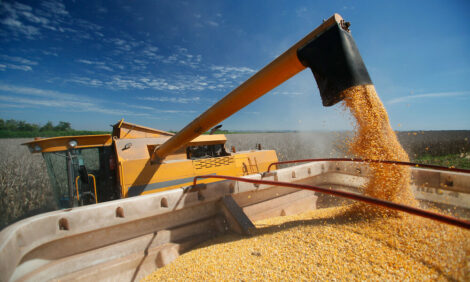



Toys for Pigs
By Penny Lawlis - Animal Care Specialist, OMAF, Canada - A European Commission welfare ruling stipulates that pigs must have "...permanent access to a sufficient quantity of material to enable proper investigation and manipulation activities, such as straw, hay, wood, sawdust, mushroom compost, peat." This ruling became law in the UK in January 2003. British farmers had 90 days to supply toys for pigs or face stiff fines of up to one thousand pounds or three months in jail.
Officially, farmers are being instructed to give pigs "environmental enrichment" by providing "manipulative material" which the UK Department for Environment, Food and Rural Affairs (DEFRA) has defined as balls, such as old footballs, basketballs or commercial pig balls. There is a special "Edinburgh Foodball" device which simulates natural foraging. Potentially toxic or gut-obstructive devices, such as old car tires, are not permitted.
Farmers also need to change the toys so the pigs don’t get tired of the same one. Research looking at toys (without improved pen design) has shown that toys only stimulate behaviour when they are "novel" (Beattie et al., 1995).
In Denmark, enrichment for penned pigs will become mandatory in 2005. A device called the "Bite-Rite" has been introduced by a manufacturer in Denmark. Similar steps are being taken in Germany, where producers have been instructed to provide 20 seconds of attention per day for each pig as well as toys and soft bedding.
These rules are based on research investigating the relationship between environmental enrichment and behaviour. Basically, this research has shown that welfare is improved through environmental enrichment (usually in the form of straw or other substrates). Pigs like to explore their environment (Beattie et al. 1995). In some settings, environments might lack sufficient stimuli for pigs, hence they explore their pen mates, which leads to high levels of harmful social behaviour (tail-biting and belly nosing). Environmental enrichment can stimulate behaviour patterns similar to those of pigs in semi-natural settings (Beattie et al. 1995). Appropriate environmental enrichment can reduce the incidence of abnormal behaviours both in absolute terms and in the proportion of time that animals spend performing them (Young et al. 1994).
Young et al (1994) studied the effects of the Edinburgh Foodball (Figure 1). Although they initially used the foodball to investigate the relationship between feeding motivation and rooting, they also examined its effect on behaviour. The research was designed to make a preliminary assessment of the foraging device’s potential for behavioural enrichment (Young et al. 1994). They looked specifically at gilts (six) and found that the use of the foodball increased the amount of time the gilts spent rooting, even when there was other material (straw) to manipulate. However, they concluded that the use of the foodball was dependent upon food reinforcement and that without food, the foodball had little reinforcing properties (Young et al. 1994). This finding provides some background to DEFRA’s advice to farmers to change toys regularly – for a behavioural enrichment device to have a positive long term effect it must provide more reinforcement than its initial novelty value (Young et al. 1994).
Crowding of pigs during the grower-finisher phase can reduce growth rate and feed conversion (Pearce and Paterson 1993). Pearce and Paterson(1993) looked at this issue with a different twist – they hypothesized that the chronic stress of overcrowding could be alleviated by the simple addition of toys (Pearce and Paterson 1993).
Their study involved 42 crossbred pigs raised under three different experimental conditions – uncrowded, crowded and crowded with toys. The pens in the last treatment were fitted with various toys, which were alternated each week. The toys consisted of four chains (or cloth strips) suspended 30 cm above the floor and equally distributed over the pen, two lifter bars (or swivel wheels) fixed to the pen walls and one rubber tire (or dustbin lid) suspended from the wall of the pen (Pearce and Paterson 1993).
Overcrowding has been reported to reduce productivity for various reasons. Pearce and Paterson (1993) concluded that reduced productivity in their experiment was due to poorer feed conversion efficiencies in the crowded pens. Interestingly, the results from this research showed that the presence of toys did not alleviate the negative effects of overcrowding – leading to the caution that the provision of toys for pigs cannot be seen as a blanket solution to improve the welfare of pigs in all situations.
Minimum Standards for the Protection of Pigs in the EU
Pearce, G.P and Paterson, A. M. 1993. The effect of space restriction and provision of toys during rearing on the behaviour, productivity and physiology of male pigs. Appl. Anim. Behav. Sci. 39:11-28.
Young, R.J., Carruthers, J. and Lawrence, A.B. 1994. The effect of a foraging device (the ‘Edinburgh Foodball’) on the behaviour of pigs. Appl. Anim. Behav. Sci. 39:237-347.
Source: Penny Lawlis - Animal Care Specialist, OMAF, Canada - April 2003.
Farmers also need to change the toys so the pigs don’t get tired of the same one. Research looking at toys (without improved pen design) has shown that toys only stimulate behaviour when they are "novel" (Beattie et al., 1995).
In Denmark, enrichment for penned pigs will become mandatory in 2005. A device called the "Bite-Rite" has been introduced by a manufacturer in Denmark. Similar steps are being taken in Germany, where producers have been instructed to provide 20 seconds of attention per day for each pig as well as toys and soft bedding.
These rules are based on research investigating the relationship between environmental enrichment and behaviour. Basically, this research has shown that welfare is improved through environmental enrichment (usually in the form of straw or other substrates). Pigs like to explore their environment (Beattie et al. 1995). In some settings, environments might lack sufficient stimuli for pigs, hence they explore their pen mates, which leads to high levels of harmful social behaviour (tail-biting and belly nosing). Environmental enrichment can stimulate behaviour patterns similar to those of pigs in semi-natural settings (Beattie et al. 1995). Appropriate environmental enrichment can reduce the incidence of abnormal behaviours both in absolute terms and in the proportion of time that animals spend performing them (Young et al. 1994).
Young et al (1994) studied the effects of the Edinburgh Foodball (Figure 1). Although they initially used the foodball to investigate the relationship between feeding motivation and rooting, they also examined its effect on behaviour. The research was designed to make a preliminary assessment of the foraging device’s potential for behavioural enrichment (Young et al. 1994). They looked specifically at gilts (six) and found that the use of the foodball increased the amount of time the gilts spent rooting, even when there was other material (straw) to manipulate. However, they concluded that the use of the foodball was dependent upon food reinforcement and that without food, the foodball had little reinforcing properties (Young et al. 1994). This finding provides some background to DEFRA’s advice to farmers to change toys regularly – for a behavioural enrichment device to have a positive long term effect it must provide more reinforcement than its initial novelty value (Young et al. 1994).
Crowding of pigs during the grower-finisher phase can reduce growth rate and feed conversion (Pearce and Paterson 1993). Pearce and Paterson(1993) looked at this issue with a different twist – they hypothesized that the chronic stress of overcrowding could be alleviated by the simple addition of toys (Pearce and Paterson 1993).
Their study involved 42 crossbred pigs raised under three different experimental conditions – uncrowded, crowded and crowded with toys. The pens in the last treatment were fitted with various toys, which were alternated each week. The toys consisted of four chains (or cloth strips) suspended 30 cm above the floor and equally distributed over the pen, two lifter bars (or swivel wheels) fixed to the pen walls and one rubber tire (or dustbin lid) suspended from the wall of the pen (Pearce and Paterson 1993).
Overcrowding has been reported to reduce productivity for various reasons. Pearce and Paterson (1993) concluded that reduced productivity in their experiment was due to poorer feed conversion efficiencies in the crowded pens. Interestingly, the results from this research showed that the presence of toys did not alleviate the negative effects of overcrowding – leading to the caution that the provision of toys for pigs cannot be seen as a blanket solution to improve the welfare of pigs in all situations.
Further Information
Further information on the topics raised in this article:Minimum Standards for the Protection of Pigs in the EU
References:
Beattie, V.E., Walker, N. and Sneddon, I.A. 1995. Effects of environmental enrichment on behaviour and productivity of growing pigs. An. Welf. 4:207-220.Pearce, G.P and Paterson, A. M. 1993. The effect of space restriction and provision of toys during rearing on the behaviour, productivity and physiology of male pigs. Appl. Anim. Behav. Sci. 39:11-28.
Young, R.J., Carruthers, J. and Lawrence, A.B. 1994. The effect of a foraging device (the ‘Edinburgh Foodball’) on the behaviour of pigs. Appl. Anim. Behav. Sci. 39:237-347.
Source: Penny Lawlis - Animal Care Specialist, OMAF, Canada - April 2003.










